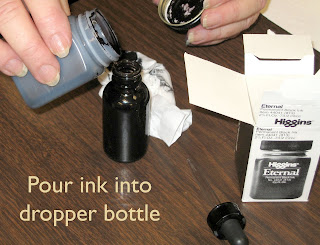 |
| Detail of Satomi's name-tag |
Beverly Hills Adult School Uncial Class #2: The handouts this week are the monoline Uncial stroke sequence sheet, a chisel-point Uncial stroke sequence sheet, and a packet of Uncial examples. DeAnn had us warm-up by writing letters with the Speedbal B1 nib and an x-height of 1-inch. Then we practiced writing our names so we could make a name-tag for ourselves. We then painted the counterspaces with watercolors.
Setting up your workspace for watercolors: have 2 water containers, one for dirty, one for clean. Always rinse brush in the dirty container first, then rinse again in the clean container. DeAnn highly recommends the 16-color Prang watercolor set, which is full of bright colors and is quite economical.
Use the lids of the Prang watercolor set as your palette. Soften the pan with a couple drops of water, then put the colors you want to use in a clean palette space and add drops of water to thin the watercolor to an ink consistency. The Prang colors stay vibrant even with considerable thinning. If you use the watercolor pan itself as the palette, the ink will get thicker and thicker.
Watercolor brushes: The best quality brushes are sable Winsor Newton Series 7. DeAnn recommends getting sizes 2, 1, and 00. These brushes can be expensive. A more economical brush is the Utrecht equivalent of a Winsor Newton Series 7 (see Suppliers). Be sure to ask for the tube to store it in so that it will stay pristine if you go to Utrecht’s.
Creating name-tags: DeAnn handed out strips of Rives BFK paper. First line the paper so you have guidelines with an x-height of 1-inch, i.e. the waistline/headline and baseline are 1-inch apart. Line-up the bottom of the C-thru ruler with the bottom of the strip and draw a line; center it.
Then turn the paper and using the inch-line (the middle line of the ruler), draw a line 1-inch away.
Write your name in black ink with the Speedball B1 nib. Let it dry completely.
Then paint the counterspaces (the whitespace of the letters) with watercolors.
Use a size 2 watercolor brush. First wet the counterspace with water, leaving a thin “moat” of dry paper next to the ink stroke itself. Because Higgins Eternal is not a waterproof ink, wetting it will cause it to bleed. Then add a color into the wet area, letting the watercolor spread to the edge of the “moat”.
Also paint the space between the letters. Let the penciled waistline and baseline be the limits. For the beginning and end, let the watercolor fade away by spreading the color with water.
This technique can be used to make a unique card or other personalized application.
 |
| Satomi painted flower petals to match the shape of the A's counterspace |
Writing Sequence for the following week:
1. Write with the Speedball B1 nib at an x-height of 1-inch.
2. Write with the Speedball B6 nib at an x-height of 1-inch.
3. Then write with the Speedball B6 nib at an x-height of ½-inch (4 boxes). You’ll need to line the paper.
Lining the grid paper: Using the 18” C-thru ruler easily creates a 2-inch margin on each side of the 17x22 sheet. By placing it in the middle, you don’t have to move it back & forth, just downward as you draw the lines with a sharp pencil, preferably with 2H lead. The grid of the ruler matches the grid paper (on the 1-inch = 8 boxes side of the double-sided grip paper, the Beinfang paper with the blue lines is the same-size grid on both sides). Match the appropriate line of the ruler to the grid and draw ½-inch lines between the darker lines that every inch.
If the 17x22 paper is too large and unwieldy to write on at the ½-inch x-height, tear it in half.
 |
| Speedball B6 nib, x-height = 1-inch, half page |
HOMEWORK: Practice with the smaller B6 nib. Start at an x-height of 1-inch. Then go down to an x-height of ½-inch. Practice by writing alphabet sentences. DeAnn will talk about spacing next time.
























